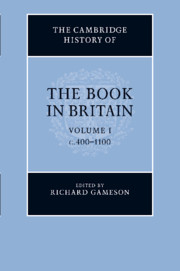Book contents
- Frontmatter
- 1 From Vindolanda to Domesday: the book in Britain from the Romans to the Normans
- PART I THE MAKING OF BOOKS
- 2 The material fabric of early British books
- 3 Anglo-Saxon scribes and scriptoria
- 4 Writing in the Insular world
- 5 Script in Wales, Scotland and Cornwall
- 6 English vernacular script
- 7 Latin script in England c. 900–1100
- 8 The design and decoration of Insular gospel-books and other liturgical manuscripts, c. 600 – c. 900
- 9 The decoration of the earliest Welsh manuscripts
- 10 Book decoration in England, c. 871 – c. 1100
- 11 Bookbindings
- PART II THE CIRCULATION OF BOOKS
- PART III TYPES OF BOOKS AND THEIR USES
- PART IV COLLECTIONS OF BOOKS
- PART V CODA
- Bibliography
- Concordance of named manuscripts
- Index of manuscripts
- General Index
- Plate 4.1: The Lindisfarne Gospels"
- Plate 5.1: The Lichfield/St Chad Gospels"
3 - Anglo-Saxon scribes and scriptoria
from PART I - THE MAKING OF BOOKS
Published online by Cambridge University Press: 28 March 2012
- Frontmatter
- 1 From Vindolanda to Domesday: the book in Britain from the Romans to the Normans
- PART I THE MAKING OF BOOKS
- 2 The material fabric of early British books
- 3 Anglo-Saxon scribes and scriptoria
- 4 Writing in the Insular world
- 5 Script in Wales, Scotland and Cornwall
- 6 English vernacular script
- 7 Latin script in England c. 900–1100
- 8 The design and decoration of Insular gospel-books and other liturgical manuscripts, c. 600 – c. 900
- 9 The decoration of the earliest Welsh manuscripts
- 10 Book decoration in England, c. 871 – c. 1100
- 11 Bookbindings
- PART II THE CIRCULATION OF BOOKS
- PART III TYPES OF BOOKS AND THEIR USES
- PART IV COLLECTIONS OF BOOKS
- PART V CODA
- Bibliography
- Concordance of named manuscripts
- Index of manuscripts
- General Index
- Plate 4.1: The Lindisfarne Gospels"
- Plate 5.1: The Lichfield/St Chad Gospels"
Summary
Among the members of a Northumbrian monastic house celebrated in verse in the early ninth century by Ædiluulf, presbiter of that community, was a certain Ultán:
He was a saintly priest of the Irish race, and he could adorn books with fair writing, and by this art he thus made the shape of the letters lovely, one after another, such that no contemporary scribe could equal him; and it is no wonder if a worshipper of the Lord could do such things, when the creating Holy Spirit already ruled his fingers and had inspired his dedicated mind to starry-heaven.
From this and the following passages we learn that the expert calligrapher was an expatriate Irishman, working at a monastic community that was dependent upon Lindisfarne, in the time of its founder-abbot Eanmund (so during the first third of the eighth century); we are told that he had a long writing career; in addition, we are informed that his skill was God-given, his work divinely inspired, and accordingly that, after death, the hand with which he had ‘merited to embellish the words of the Lord’ could work miracles. Given that Ædiluulf was writing approximately a century later and is thus unlikely to have known Ultán personally, it is also apparent that the great scribe’s memory had been kept golden within the community, and that his work remained a source of admiration and inspiration.
Keywords
- Type
- Chapter
- Information
- The Cambridge History of the Book in Britain , pp. 94 - 120Publisher: Cambridge University PressPrint publication year: 2011
- 4
- Cited by



